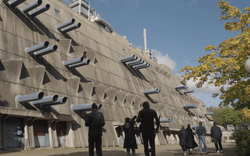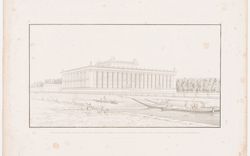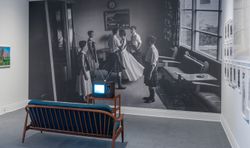drawings
DR2006:0170
1995?
drawings
1995?
drawings
DR2006:0171
1995?
drawings
1995?
drawings
AP178.S2.1982.001
Description:
This sketchbook includes sketches for the Quinta da Malagueira housing in Évora, Avelino Duarte house in Ovar, and for Bonjour Tristesse in Berlin, Germany. It also contains a draft of the article A casa do Dr. Fernando Machado: a casa interrompida, as well as a self-portrait.
January 1982
Sketchbook 98: Lojas (Evora) Casa Porto - Ovar Puxad.
Actions:
AP178.S2.1982.001
Description:
This sketchbook includes sketches for the Quinta da Malagueira housing in Évora, Avelino Duarte house in Ovar, and for Bonjour Tristesse in Berlin, Germany. It also contains a draft of the article A casa do Dr. Fernando Machado: a casa interrompida, as well as a self-portrait.
drawings
January 1982
drawings
Research drawings and maps
AP197.S2.060
Description:
Drawings in this box include: Alvar Aalto's Hansviertal Apartments, Berlin; the Sala della Valle by Aurelio Galfetti; the East River Bridge, ARUP + Michael Fieldman & Partners with Harry Wolf. This box also includes maps of the trans-contintental railways of North America, Ireland, Calcutta and more.
circa 1980-2000
Research drawings and maps
Actions:
AP197.S2.060
Description:
Drawings in this box include: Alvar Aalto's Hansviertal Apartments, Berlin; the Sala della Valle by Aurelio Galfetti; the East River Bridge, ARUP + Michael Fieldman & Partners with Harry Wolf. This box also includes maps of the trans-contintental railways of North America, Ireland, Calcutta and more.
drawings
circa 1980-2000
articles
Architecting a Change
Forces of Friction
9 December 2024
Architecting a Change
Federica Zambeletti in conversation with Arno Brandlhuber and Olaf Grawert
Actions:
Forces of Friction
Territories are the complex set of relations to things that keep us alive. They are bound spaces, where intersecting borders establish semi-stable relations between polities and their material base of operations. A new intensification is reshaping the surface and the cycles of the Earth: the Anthropocene marks an exit from modern forms of territorial organization of(...)
Paul-Desmarais Theatre
5 November 2015
John Palmesino: Territorial Agency
Actions:
Description:
Territories are the complex set of relations to things that keep us alive. They are bound spaces, where intersecting borders establish semi-stable relations between polities and their material base of operations. A new intensification is reshaping the surface and the cycles of the Earth: the Anthropocene marks an exit from modern forms of territorial organization of(...)
Paul-Desmarais Theatre
8 January 2024
Day at the Office, Night at the Opera with Karl Friedrich Schinkel
A lecture by Kurt W. Forster
Actions:
articles
8 January 2024
In an age of unprecedented human impact on the planet, certain countries stand out for their privileged positions and the complexity of their relationships with the land. Stories about Canada closely follow the discovery and appropriation of vast and varied natural resources as well as changing ideas of the proper relationship between people and their environment.(...)
16 November 2016 to 9 April 2017
It’s All Happening So Fast
Actions:
Description:
In an age of unprecedented human impact on the planet, certain countries stand out for their privileged positions and the complexity of their relationships with the land. Stories about Canada closely follow the discovery and appropriation of vast and varied natural resources as well as changing ideas of the proper relationship between people and their environment.(...)
drawings
AP178.S2.1989.002
Description:
This sketchbook includes notes and sketches about the reconstruction of Chiado and projects from the IBA in Berlin, Germany. It also contains sketches of Library of the University of Aveiro in Portugal, the Galician Centre of Contemporary Art of Santiago de Compostela in Spain, as well as notes of meeting and draft letter.
March 1989
Sketchbook 284: Chiado - Alcoy - Santiago
Actions:
AP178.S2.1989.002
Description:
This sketchbook includes notes and sketches about the reconstruction of Chiado and projects from the IBA in Berlin, Germany. It also contains sketches of Library of the University of Aveiro in Portugal, the Galician Centre of Contemporary Art of Santiago de Compostela in Spain, as well as notes of meeting and draft letter.
drawings
March 1989
Project
AP178.S1.1984.PR02
Description:
The project series documents the Punt en Komma social housing project in The Hague, The Netherlands, with some materials related to the Urban plan for Deelgebied Zone 5, Schilderswijk-West. While the records were held in the office’s archives the urban plan for Deelgebied Zone 5 was assigned the number 30/80 and Punt en Komma was assigned the number 30/80 A/B (Punt (A) and Komma (B)). The office assigned the date 1984 for this project. In the mid to late1970s The Hague underwent an urban renewal program and in 1980 Adri Duivesteijn became the alderman responsible for this program. Dissatisfied with the results, in the early to mid-1980s Duivesteijn began a campaign to look at urban renewal as a cultural approach, and was interested in the participatory process that Siza incorporated for the Serviço Ambulatório de Apoio Local (SAAL) in Portugal and the Berlin projects submitted to the International Architectural Exhibition Berlin competition (International Bauaustellung, IBA, circa 1979-1987). After taking a trip to Portugal, Duivesteijn invited Siza to speak with residents of Schilderswijk. The urban plan for Schilderswijk was the first part of a redevelopment plan for the 19th century district and included two four story blocks of 106 apartments, named Punt en Komma. Schilderswijk is in the centre of The Hague and is nearby the Haag Spoor train station. The residents are made up of multi-ethnic communities and included immigrants from Turkey, Morocco, Tunisia, and Portugal. Similarly to the Berlin projects, Siza was faced with cultural tensions between the residents of the area. The urban plan was to take into account the preservation of the neighborhood's identity while accounting for the changes brought on by multi-ethnic communities. As with the SAAL and Berlin projects there was an element of participation from the residents and included the collaboration of a residents association. In the “Plan of Zone 5 of Schilderswijk Centrum…”, found in this project series [AP178.S1.1984.PR02.024.1, AP178.S1.1984.PR02.024.2], it is outlined that meetings were periodically held with technicians appointed by the Department of Urban Planning and Housing of The Hague, the Housing Cooperative, and each of the designers. Siza’s design for Punt en Komma incorporated elements prevalent in Dutch architecture such as the Haagse Portiek. However, he also included components in his design which accounted for the needs of residents living there at the time. One feature which gained much attention was the incorporation of sliding doors in the apartments. Siza included these doors in his design in consideration of the cultural practices of Muslim families. Documenting this project series are drawings, photographic materials, and textual documentation. Among the drawings are plans, elevations, sections, and details, as well as axonometric drawings, such as the proposed design for Deelgebied zone 5 (including Punt en Komma) and drawings of the Haagse Porteik. Photographic materials document both Duivesteijn’s trip to Portugal and Siza’s first trip to The Hague and include photographs, negatives, and slides of the built project, as well as slides of drawings. Note that the photographic materials include photographs related to the housing and shopping complex in Schilderswijk. Textual documentation includes brochures regarding rent increases, a copy of “Stadsvernieuwing als Kulturele Aktiviteit” by Duivesteijn, and information booklets for the residents. Also included are minutes of meeting and correspondence from the Woningbouwvereniging’s-Gravenhage. Among the correspondence are letters regarding construction costs, including a letter from Siza to the local architectural firm Architectengemeenschap Van den Broek en Bakema explaining that he does not wish to modify the detail he specified for the lintels of the Punt building. There is also correspondence from project architect Carlos Castenheira and Duivesteijn and a summary of the meeting between Siza and the Committee of the Corporation for Social Housing (17 April, 1985)[AP178.S1.1984.PR02.025.1] It is important to note that Siza also participated in other projects for this urban renewal program: the housing and shopping complex in Schilderswijk [AP178.S1.1984.PR03], the Van der Vennepark [AP178.S1.1985.PR01], and the residential settlement in Schilderswijk (Plano de Doedijnstraat [AP178.S1.1989.PR03]). All three of these projects are arranged in separate project series.
circa 1981 - 1990
106 habitações, Punt en Komma [Punt en Komma social housing], Schilderswijk-West, The Hague, The Netherlands, (1981-1990)
Actions:
AP178.S1.1984.PR02
Description:
The project series documents the Punt en Komma social housing project in The Hague, The Netherlands, with some materials related to the Urban plan for Deelgebied Zone 5, Schilderswijk-West. While the records were held in the office’s archives the urban plan for Deelgebied Zone 5 was assigned the number 30/80 and Punt en Komma was assigned the number 30/80 A/B (Punt (A) and Komma (B)). The office assigned the date 1984 for this project. In the mid to late1970s The Hague underwent an urban renewal program and in 1980 Adri Duivesteijn became the alderman responsible for this program. Dissatisfied with the results, in the early to mid-1980s Duivesteijn began a campaign to look at urban renewal as a cultural approach, and was interested in the participatory process that Siza incorporated for the Serviço Ambulatório de Apoio Local (SAAL) in Portugal and the Berlin projects submitted to the International Architectural Exhibition Berlin competition (International Bauaustellung, IBA, circa 1979-1987). After taking a trip to Portugal, Duivesteijn invited Siza to speak with residents of Schilderswijk. The urban plan for Schilderswijk was the first part of a redevelopment plan for the 19th century district and included two four story blocks of 106 apartments, named Punt en Komma. Schilderswijk is in the centre of The Hague and is nearby the Haag Spoor train station. The residents are made up of multi-ethnic communities and included immigrants from Turkey, Morocco, Tunisia, and Portugal. Similarly to the Berlin projects, Siza was faced with cultural tensions between the residents of the area. The urban plan was to take into account the preservation of the neighborhood's identity while accounting for the changes brought on by multi-ethnic communities. As with the SAAL and Berlin projects there was an element of participation from the residents and included the collaboration of a residents association. In the “Plan of Zone 5 of Schilderswijk Centrum…”, found in this project series [AP178.S1.1984.PR02.024.1, AP178.S1.1984.PR02.024.2], it is outlined that meetings were periodically held with technicians appointed by the Department of Urban Planning and Housing of The Hague, the Housing Cooperative, and each of the designers. Siza’s design for Punt en Komma incorporated elements prevalent in Dutch architecture such as the Haagse Portiek. However, he also included components in his design which accounted for the needs of residents living there at the time. One feature which gained much attention was the incorporation of sliding doors in the apartments. Siza included these doors in his design in consideration of the cultural practices of Muslim families. Documenting this project series are drawings, photographic materials, and textual documentation. Among the drawings are plans, elevations, sections, and details, as well as axonometric drawings, such as the proposed design for Deelgebied zone 5 (including Punt en Komma) and drawings of the Haagse Porteik. Photographic materials document both Duivesteijn’s trip to Portugal and Siza’s first trip to The Hague and include photographs, negatives, and slides of the built project, as well as slides of drawings. Note that the photographic materials include photographs related to the housing and shopping complex in Schilderswijk. Textual documentation includes brochures regarding rent increases, a copy of “Stadsvernieuwing als Kulturele Aktiviteit” by Duivesteijn, and information booklets for the residents. Also included are minutes of meeting and correspondence from the Woningbouwvereniging’s-Gravenhage. Among the correspondence are letters regarding construction costs, including a letter from Siza to the local architectural firm Architectengemeenschap Van den Broek en Bakema explaining that he does not wish to modify the detail he specified for the lintels of the Punt building. There is also correspondence from project architect Carlos Castenheira and Duivesteijn and a summary of the meeting between Siza and the Committee of the Corporation for Social Housing (17 April, 1985)[AP178.S1.1984.PR02.025.1] It is important to note that Siza also participated in other projects for this urban renewal program: the housing and shopping complex in Schilderswijk [AP178.S1.1984.PR03], the Van der Vennepark [AP178.S1.1985.PR01], and the residential settlement in Schilderswijk (Plano de Doedijnstraat [AP178.S1.1989.PR03]). All three of these projects are arranged in separate project series.
Project
circa 1981 - 1990



